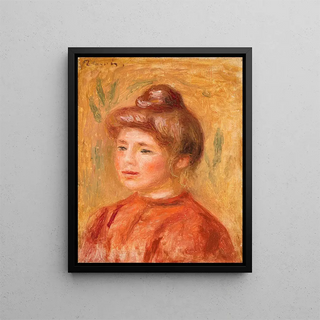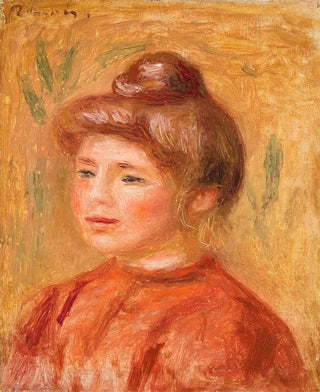Art print | Bust of Woman in Red Buste de femme en rouge - Pierre-Auguste Renoir


View from behind

Frame (optional)
In the fascinating world of art, some works manage to transcend time and capture the very essence of human emotion. "Bust of Woman in Red" by Pierre-Auguste Renoir is one of these creations. Created at the end of the 19th century, this sculpture embodies the characteristic beauty and sensuality of the Impressionist style. Through Renoir's gentle gaze, the viewer is invited to immerse themselves in a world where color and light meet harmoniously. The art print of this piece allows appreciation not only of the undeniable talent of the artist but also of the depth of the feelings it evokes.
Style and uniqueness of the work
Renoir's style is often associated with a celebration of life, and "Bust of Woman in Red" is no exception. This sculpture stands out for its bold use of red, which immediately draws the eye and creates a vibrant atmosphere. The way Renoir shapes forms and volumes demonstrates his exceptional mastery of modeling. The woman's face, delicately sculpted, expresses a softness and serenity that capture the present moment. The meticulous details, such as delicate features and skin texture, reveal the artist's sensitivity to feminine beauty. This work, with its blend of realism and stylization, perfectly embodies the spirit of the Impressionist era, where light and color are explored in innovative ways.
The artist and his influence
Pierre-Auguste Renoir, an iconic figure of the Impressionist movement, left a lasting mark on art history with his unique vision and innovative approach. Born in 1841, he was initially influenced by classical masters before turning to a freer exploration of light and color. Renoir always sought to capture the joy of living and the beauty of the world around him, and the art print of "Bust of Woman in Red" is a perfect illustration of this. His influence extends far beyond his time, inspiring many contemporary and future artists to embrace color and light as means of expression. Through his works, Renoir opened

Matte finish

View from behind

Frame (optional)
In the fascinating world of art, some works manage to transcend time and capture the very essence of human emotion. "Bust of Woman in Red" by Pierre-Auguste Renoir is one of these creations. Created at the end of the 19th century, this sculpture embodies the characteristic beauty and sensuality of the Impressionist style. Through Renoir's gentle gaze, the viewer is invited to immerse themselves in a world where color and light meet harmoniously. The art print of this piece allows appreciation not only of the undeniable talent of the artist but also of the depth of the feelings it evokes.
Style and uniqueness of the work
Renoir's style is often associated with a celebration of life, and "Bust of Woman in Red" is no exception. This sculpture stands out for its bold use of red, which immediately draws the eye and creates a vibrant atmosphere. The way Renoir shapes forms and volumes demonstrates his exceptional mastery of modeling. The woman's face, delicately sculpted, expresses a softness and serenity that capture the present moment. The meticulous details, such as delicate features and skin texture, reveal the artist's sensitivity to feminine beauty. This work, with its blend of realism and stylization, perfectly embodies the spirit of the Impressionist era, where light and color are explored in innovative ways.
The artist and his influence
Pierre-Auguste Renoir, an iconic figure of the Impressionist movement, left a lasting mark on art history with his unique vision and innovative approach. Born in 1841, he was initially influenced by classical masters before turning to a freer exploration of light and color. Renoir always sought to capture the joy of living and the beauty of the world around him, and the art print of "Bust of Woman in Red" is a perfect illustration of this. His influence extends far beyond his time, inspiring many contemporary and future artists to embrace color and light as means of expression. Through his works, Renoir opened






